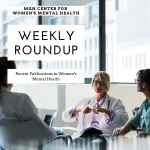In two studies, researchers demonstrated that maternal depression during pregnancy is associated with worse child outcomes: more health problems in infants (Coburn et al 2018) and increased anxiety and depressive symptoms in older children (Glynn et al 2018). Also of interest are the next two articles which indicate that depressive symptoms within the first day of delivery may be useful for predicting postpartum depressive symptoms later on (Marín-Morales et al 2018, Miller et al 2017).
Ruta Nonacs, MD PhD
Prenatal maternal mood patterns predict child temperament and adolescent mental health.
Glynn LM, Howland MA, Sandman CA, Davis EP, Phelan M, Baram TZ, Stern HS. J Affect Disord. 2018 Mar 1;228:83-90.
Prenatal exposure to more elevated maternal mood entropy predicted higher levels of child negative affectivity at 12 months, 24 months and 7 years of age. In addition, children exposed to higher prenatal maternal mood entropy, reported higher levels of anxiety symptoms at 10 years and elevated depressive symptoms at 13 years. These associations persisted after adjusting for levels of maternal depressive symptoms during the postpartum period.
Prenatal Maternal Depressive Symptoms Predict Early Infant Health Concerns.
Coburn SS, Luecken LJ, Rystad IA, Lin B, Crnic KA, Gonzales NA. Matern Child Health J. 2018 Feb 9.
In a prospective study of low-income Mexican American mothers, higher prenatal depressive symptoms were associated with more infant physical health concerns at 12 weeks (p < .001), after accounting for 12-week maternal depressive symptoms, breastfeeding, gestational age, and birth weight.
Marín-Morales D, Toro-Molina S, Peñacoba-Puente C, Losa-Iglesias M, Carmona-Monge FJ. Matern Child Health J. 2018 Feb 8.
At 24 hours postpartum, symptoms of depression, trait anxiety, and state anxiety were all significantly correlated with each other. Depression at 24 h postpartum was the only significant independent predictor of depression at 4 months postpartum.
Immediate postpartum mood assessment and postpartum depressive symptoms.
Miller ML, Kroska EB, Grekin R. J Affect Disord. 2017 Jan 1;207:69-75. Free Article
After birth, the Daily Experiences Questionnaire (DEQ) was used to measure positive affect and negative affect. Low positive affect and high negative affect after birth significantly predicted depressive symptoms early (at 2 weeks) and later (at 12 weeks) in the postpartum period, over and above previous traumatic experiences and history of depression.
Lau Y, Htun TP, Kwong HKD. PLoS One. 2018 Feb 8. Free Article
Using the EPDS to screen for depressive symptoms during the second and third trimesters and at six weeks postpartum, researchers observed that the intensity of depressive symptoms was highest in the second trimester and predicted depressive symptoms during the third trimester and after delivery. Unmarried status, unplanned pregnancy, gestational diabetes, and headache were significantly associated with higher depressive symptoms during pregnancy.
Reddy MSS, Thippeswamy H, Ganjekar S, Nagappa M, Mahadevan A, Arvinda HR, Chandra PS, Taly AB. Arch Womens Ment Health. 2018 Feb 7.
Birth experiences, trauma responses and self-concept in postpartum psychotic-like experiences.
Holt L, Sellwood W, Slade P. Schizophr Res. 2018 Feb 2.
A more negative birth experience directly predicted delusions, but not hallucinations. Trauma appraisals and poorer adjustment to motherhood indirectly predicted psychosis-like experiences. Post-traumatic stress symptoms directly predicted the occurrence of psychotic symptoms.
Schuette SA, Kominiarek MA, Wisner KL, Massey SH. AJP Rep. 2018 Jan;8(1):e13-e17. Free Article
Being overweight before pregnancy was associated with a dramatically increased risk of third trimester depression, independent of past history of depression and marital status (odds ratio?=?7.47).
Female psychopharmacology matters! Towards a sex-specific psychopharmacology.
Bolea-Alamanac B, Bailey SJ, Lovick TA, Scheele D, Valentino R. J Psychopharmacol. 2018 Jan 1.
Postpartum Depression Screening Tools: A Review.
Ukatu N, Clare CA, Brulja M. Psychosomatics. 2017 Nov 23.
No tool could be deemed best at accurately detecting PPD on the basis of sensitivity and specificity. Additionally, there was no recommended time period during which screening should be done.
Grekin R, Brock RL, O’Hara MW. J Affect Disord. 2017 Aug 15;218:269-276.
On average, depressive symptoms decreased from pregnancy to 24 months postpartum; however, trajectories varied across women. Single relationship status, substance use, and trauma history were each predictors of higher depression levels at several points in time across the observed perinatal period.
Patterns of change in anxiety and depression during pregnancy predictpreterm birth.
Doktorchik C, Premji S, Slater D, Williamson T, Tough S, Patten S. J Affect Disord. 2018 Feb;227:71-78.
Women who experienced an increase in anxiety scores, (32-36 weeks compared to 17-24 weeks) had 2.70 times higher odds of preterm delivery, compared to those with a reduction in anxiety scores. Consistent low or high depression scores did not significantly influence the odds of PTB compared to a decrease in depression scores.
Khatri GK, Tran TD, Baral S, Fisher J. J Affect Disord. 2018 Mar 1;228:238-247.
Depressive symptoms were prevalent among women who had experienced the Nepal earthquake during pregnancy: 21.9% of participants had EPDS scores > 12 and another 17.1% scored 10-12 indicating a high prevalence of clinically significant depressive symptoms. Seven factors, including earthquake experiences and lifetime experience of intimate partner violence, increased risk and five including having income-generating work and a kind, and encouraging partner were protective.





Leave A Comment